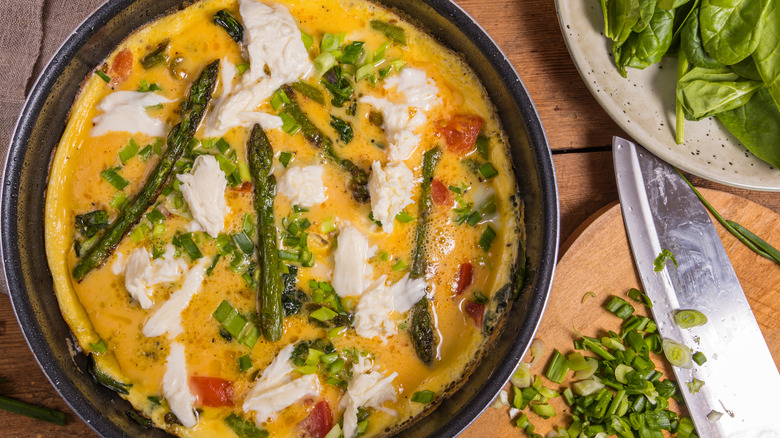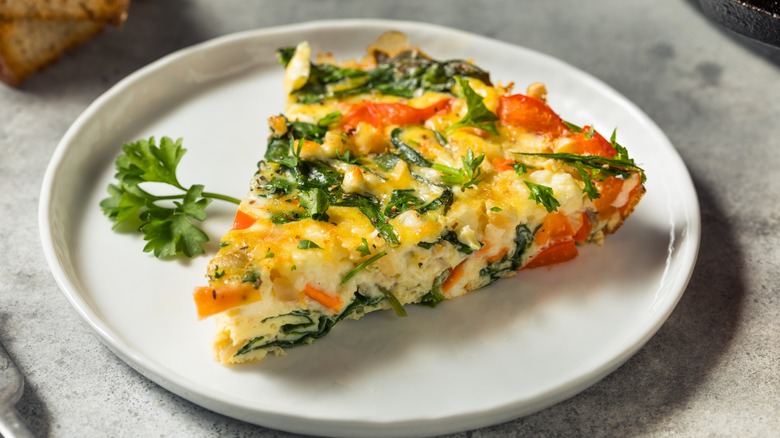A Frittata Is One Of The Easiest Egg Dishes For Using Up Random Leftovers
It's the end of the week and you're hungry. You think you only have a carton of eggs left, but you open the fridge and find other bits and bobs: nubbins of roast chicken, little lumps of various cheeses, and two take-out containers of stir-fried vegetables. What can you make for dinner? A fridge clean-out frittata, of course!
Frittatas are the rustic neighbors of crustless quiches and omelets, with filling ingredients mixed into beaten eggs and cooked on the stove ("frittata" is a play on "fritta," which is "fried" in Italian). When making egg dishes like these, the fillings generally need to be pre-cooked so that they won't still be raw by the time the eggs are set. By using leftovers as fillings for your frittatas, you will have skipped the pre-cooking step altogether!
To use up leftovers in a frittata, simply chop up the ingredients you'll be using into small, bite-sized pieces, and add them into an ovenproof skillet. Pour in enough beaten eggs to cover the chopped leftovers, then put it over low heat to cook the bottom of the frittata before placing the whole thing under the broiler to completely set the eggs. The frittata can be served hot, cold, or even at room temperature, cut into slices for easy eating.
Keep your fridge organized
Eating leftovers straight up can be boring and repetitive, but trying to assemble them into entirely new dishes takes far too much effort for tired minds at the end of a workday. Frittatas take the guesswork out — just mix said leftovers into eggs.
No leftovers? No way. Chances are extremely high that if you cook, you'll have leftovers in your fridge. No matter how carefully one portions and follows meal plans, there will almost always be extras that would be too wasteful to throw away. The trick then is to think ahead and organize your fridge, so you are on top of your leftovers — whether they be raw ingredients (think presliced carrots for big salads) or cooked meals.
Key tips for leftover organization include placing the oldest leftovers at the front of the shelves, so you'll use them first, and investing in good-quality see-through and airtight containers — so you'll know what's lurking in your fridge. Then, when the inevitable leftovers accumulate, you'll know what to use and when to use them — say, in a frittata.
Always have eggs in your pantry to experiment with flavor
When combining seemingly disparate ingredients and leftovers together in a frittata, think about the flavors they contribute. It might not seem obvious at first glance if the components will work well together, but you'd be surprised. Leftover chicken curry and a small block of cheddar may sound strange, but curry and cheese are a beloved combination in Japan. How about leftover Kung Pao pork and a wilting tomato? Tomatoes and eggs are already a common dish in Chinese eateries, and combining them with pork simply skips the step of eating them as separate dishes.
If you're stumped, Scientific American has created an interactive chart outlining various flavor connections. Tuna and lemon is a fairly obvious pairing. But who knew about peanut butter and roast beef? Or strawberries and mussels? There's a whole world of complementing and contrasting flavors to explore, and the perfect vehicle may just be the humble frittata. Just remember to always have eggs in the fridge! Or turn your attention to that other leftover canvas, the always-flexible fried rice.


